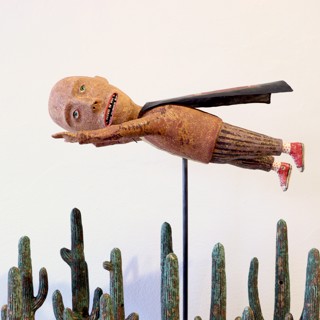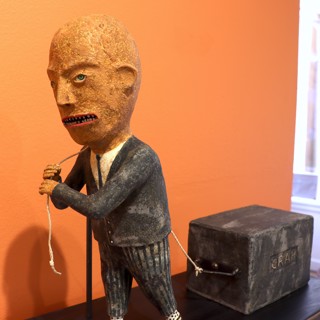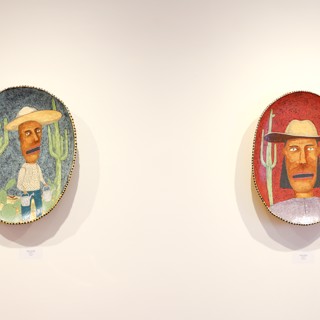Wesley Anderegg was born in Phoenix, Arizona in 1958,and the colors and images of his youth in the Southwest are never far from his work. His ceramic sculptures often feature motifs like long-eared jackrabbits, Coors beer cans, saguaros, rattlesnakes and roadrunners—yet his work is far from the tourist fare that typically shares these visual tropes, and is by turns provocative, witty and disquieting. His color schemes range from the muted browns, yellows and greens of those desert landscapes to bright, garish hues that startle the eye and provoke the imagination.
Anderegg returns to Hecho a Mano this year with a new show, Sonora, that features ceramic sculptures and large wall plates that show “snippets from growing up in the land of cactus,” the artist says.


His start in ceramics was serendipitous: while studying geography at Arizona State University, he happened to take an elective in the medium. Captivated, he went on to study it further at the Anderson Ranch Arts Center in Snowmass Village, Colorado and again at the Archie Bray Foundation in Helena, Montana, and was a resident artist at both sites. His practice evolved from wheel-thrown pottery to hand-building, which remains the basis of his sculptural and narrative work. Moving from pinch pots, to small figurines, to larger sculptures, his work evolved into what it is today: an exuberantly strange world populated by curious, angry little beings.
Anderegg’s work has been exhibited widely across the United States, and has appeared in numerous books and magazines including “Confrontational Ceramics: The Artist as Social Critic” by Judith Schwartz, “A Potters Handbook” by Glenn Nelson and Richard Burkett, “Handbuilt Ceramics” from Lark Books, “Ceramics Monthly” and “American Craft.” His work has won several awards and accolades, and is held in public collections including the Renwick Gallery at the Smithsonian American Art Museum, the Archie Bray Foundation, the Mint Museum of Craft and Design, the Fredrick R. Wiesman Museum in Minneapolis, Minnesota, the Columbus Museum in Columbus, Georgia, the Crocker Art Museum in Sacramento, California.
“As far as my work goes,” he says,
“I just keep thinking and moving forward trying to make the best stuff I can.”
Anderegg now works from his studio in the Santa Rita Hills wine region in California—an old horse barn that he shares with his wife, Donna, who makes functional ceramics. He continues to create ceramic sculptures and wall plates featuring human and humanoid figures characterized by their deadpan expressions and wide, toothy mouths. Their whimsical, offbeat characteristics are instantly recognizable, and Anderegg’s darkly humorous presentation of narrative sculpture draws audiences’ attention to political, social and environmental issues through a satirical lens.
This year, Anderegg’s show will feature the mixed media sculptures in clay, wood and steel that exemplify his practice, as well as large ceramic wall plates. His clay figures are mounted on wooden bases with metal armatures to hold them in place. Inspired by primitive clay figures, rustic folk and outsider art forms, his sculptures often depict people and humanoid figures either in isolation or as part of a narrative vignette. The ceramic plates illustrate portraits of similar figures. Both share a style of surface decoration that is striking, colorful and sometimes cartoonish, with macabre and sinister undertones.




For this show, though, Anderegg was inspired not by any specific concept, but by a mood:
“There really is no theme to the show but more of a feeling of time and place—if anything, I hope to give the feeling of a simpler time,” Anderegg says.
